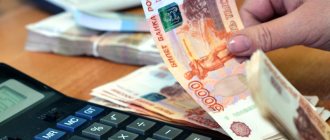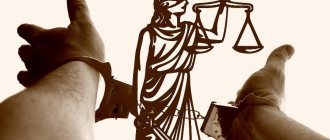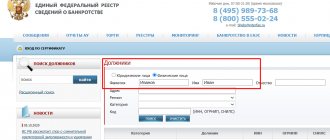Recognition of a company's financial insolvency in court does not guarantee the absence of obligations on the part of its manager, shareholders, founders, chief accountant and other officials. Vicarious liability in bankruptcy is a common exclusive mechanism for protecting the interests of creditors, restoring their rights and preventing the fictitiousness of the procedure. The possibility of its application depends on the degree of guilt of management and the organizational and legal form of the legal entity. The controlling person may not be aware that, by law or contract, he is financially responsible for actions or omissions that contributed to bankruptcy. Legal provides professional legal support, develops a strategy to avoid subsidiary liability in bankruptcy, and provides comprehensive legal and financial services. We make every effort to minimize risks and provide clients with a reliable legal status.
What is subsidiary liability and who can it apply to?
Situations are different, and any company can go bankrupt. But you can’t just declare yourself bankrupt and close the company. Debts to government agencies and other creditors must be paid.
When a company cannot pay its debts, creditors, tax authorities and many others have the right to demand them from persons bearing subsidiary liability. These are all persons who conducted transactions on behalf of the organization or performed actions affecting its activities. The main contender in this case is the head of the organization.
The amount of subsidiary liability is established in the amount of the outstanding debt.
When can they be held vicariously liable?
The head of an organization can be held accountable only if all creditors’ demands are not met after the company is fully declared bankrupt.
The following circumstances may serve as reasons for this:
- the manager brought the company to bankruptcy through his actions;
- initiated a false bankruptcy;
- did not take any action to bring the company out of bankruptcy;
- an application for possible bankruptcy was not submitted to the arbitration court on time;
- the data of accounting and corporate documentation was not transmitted or was distorted;
- requirements were violated during the company's insolvency proceedings.
If none of the circumstances are met, the manager cannot be held vicariously liable.
But if the arbitration manager has discovered at least one of these points, he begins to collect papers proving the involvement of third parties in the bankruptcy of the company in order to hold the perpetrators accountable.
What to do if you are still hired as a subsidiary
There are not so many methods to get rid of subsidiary liability. And it is much easier to “disown” her even at the stage of bankruptcy of the enterprise than to later prove that you were attracted to the subsidy “for nothing.”
If an individual is nevertheless forced to answer for someone else’s debts, you need to act as follows
:
- File a counterclaim and attach evidence of your non-involvement in the organization’s debt.
- Contact lawyers who will help you get rid of the debt burden using legal methods (for example, they will prove that the company’s bankruptcy was carried out with violations).
If you need protection from subsidiary liability, contact credit lawyers by phone or ask your question in the online chat window. The sooner you take action, the higher the chance of avoiding consequences.
Let us help you legally write off debts
A lawyer will call you back in 1 minute and provide advice. It's free.
Liability for inaction in bankruptcy
In the event of bankruptcy, a clear inaction will be the absence of an application to the arbitration court to declare the company insolvent.
This is significant evidence to hold the manager vicariously liable.
To avoid liability for inaction, you should be the first to apply to the arbitration court when the company:
- will be able to cover the debts of only one or several creditors, but not all;
- the company's property is not enough to cover the full list of obligations;
- after the collection of property, the company will not be able to conduct its activities.
But there are always exceptions, and the absence of a statement in these cases can be justified by the presence of insurmountable circumstances that prevented it from being filed in court.
Who is at risk in a troubled LLC?
If a business is in debt and short of money, the people who ran it are responsible. The law calls them controlling persons. These include:
- director;
— founders;
- the actual owner of the business - when the share of the LLC was registered to a dummy person or the company was opened to split the business and evade taxes;
- chief accountant, accountant - that is, the person who was responsible for payment;
- dummy directors and participants - until they prove that they were listed only in the constituent documents, and another person received the benefit.
It is these individuals who risk being subject to subsidiary liability. This approach is described in Art. 53.1 Civil Code of the Russian Federation, art. 61.10 of the Bankruptcy Law and clauses 3 and 7 of the Resolution of the Plenum of the Armed Forces of the Russian Federation dated December 21, 2017 No. 53.
If several people are at fault, the debts are paid jointly. This means that the creditor will present a writ of execution to the most solvent person and collect the entire debt. The one who pays for everyone will be able to collect shares from the remaining debtors. But already on my own.
Let us reassure you right away: personal liability does not automatically arise for debts in an LLC. A person pays only when the company has no money due to his fault. The courts deal with guilt and debts. And creditors must go to the courts.
Procedure for attraction
After a company is declared bankrupt, creditors whose claims have not been satisfied take the following actions to bring them to subsidiary liability:
- the court receives a decision that the debtor company is declared bankrupt;
- determine the amount of debt that the company has not paid them;
- receive confirmation that proves that the debtor company does not have property capable of repaying the debt;
- submit an application to bring certain persons influencing the company's activities to subsidiary liability to the arbitration court.
When does the subsidiary liability of the founders and directors arise?
Involvement in the ruin is proven through concluded transactions, according to the minutes of meetings at which decisions were made, according to orders issued, according to contracts signed on behalf of the company. Managers bear subsidiary liability if it can be proven
, What:
- transactions were made that caused irreparable losses;
For example, purchased a batch of equipment for 3 million rubles and sold it for 2.5 million. The fairness and transparency of the transaction are questionable here.
- management entered into agreements with obviously dubious counterparties, or the terms of the agreements were hidden;
- important documents are lost;
If some information is missing, the court always holds management vicariously liable. - transactions requiring the approval of the Board of Directors or founders were carried out individually.
Example: one partner goes abroad, and the second makes unprofitable deals and ruins the company. There is a suspicion of bankruptcy.
- it was established that the recognition of insolvency was delayed;
Management is obliged to file bankruptcy with the arbitration court no later than 30 days from the moment when it is established that it is impossible to pay creditors.
The key factor in proving guilt is deliberate harm to the economic position of the company
. Errors in management that were not made on purpose and not for the purpose of ruin, the court can justify and release the company from paying debts.
Responsibility of the chief accountant
A subsidy is provided for the chief accountant if he gave financial instructions to management or untimely reported losses and financial insolvency.
In addition, the chief accountant faces subsidiary liability
if he:
- was a member of the executive body, for example, the Board of Directors;
- benefited from illegal actions, deliberately led the company to default on debts;
- made errors in reporting or lost (hidden) accounting documents;
- owned or had the right to dispose of more than 50% of the shares, interests or authorized capital of the company.
It doesn’t matter whether the accountant worked on staff, under a contract or on a freelance basis. If the court proves the specialist’s involvement in bankruptcy, subsidiary liability cannot be avoided.
Relatives of the subsidiary defendant
The list of potential subjects of subsidiary liability is not limited to the big bosses of the company. Former managers (who quit within two years before the bankruptcy of the organization), relatives, friends and business partners of the current management - in a word, everyone who could influence decision-making and benefit from it - can be found guilty of bankruptcy of a company.
The subsidiary liability of the property owner will arise if it is confirmed that the company’s money was used to purchase real estate, cars and other valuables for private use. It is difficult, but possible, to prove the involvement of third parties in the shadows in the ruin of the company.
Here are some examples of such situations:
- During the management of the company by citizen N., his relatives acquired shares, large sums in their accounts or property. If the manager registered what was purchased in his name and then gave it to loved ones, such transactions will be challenged
, and everything donated will be taken away. - The relatives (spouses, children, parents) of the head of the company do not have much income, but suddenly, after withdrawing money from the company’s accounts, they got houses, cars
, and expensive shares. Creditors will be able to prove that all these are gifts at the expense of the bankrupt company. The scenario is the same - they will take everything. - Relatives have independent high income. The court will check whether they have enough of their own funds for the purchase. If transactions are transparent (confirmed by account statements, inheritance, and so on), the owner of the property does not bear subsidiary liability.
Liability for the obligations of a legal entity is borne only by those who are actually involved in the deterioration of the financial position of the company. Just like that, in the event of the bankruptcy of a company, no one will involve relatives of the founders, directors or other employees in paying off debts. If there were no dubious transactions, there is nothing to fear.
Stages of attraction
Creditors may include banks, suppliers who have not been paid for goods, and even employees who have been left without wages. But in the case of judicial prosecution, it does not really matter who exactly is the defrauded creditor.
In general terms , the procedure for collecting subsidiary liability
next:
- The creditor becomes convinced that the debtor does not pay and submits a written claim.
- The debtor reports that he will not be able to fulfill his obligations, or does not respond to the claim for more than 7 days.
- The creditor approaches the subsidiary debtor with a demand for payment.
- The latter sends the main debtor a notice of the creditor's claims.
- If the subsidiary debtor does not agree with the conditions presented by the creditor, he files a claim in court. The main debtor automatically becomes a co-defendant.
- The debt in the amount established by the court is paid by the subsidiary debtor or collected from him.
The procedure for collecting subsidiary liability and what can be taken away
The starting point for collecting debt from a subsidiary defendant is a court decision declaring the company bankrupt. Then:
- Determine the amount of debts to each creditor.
- A bankruptcy estate is formed from the bankrupt’s property, subject to auction.
- If the amount after the sale of property is not enough to repay, the circle of persons who influenced the bankruptcy of the company is identified.
- These persons are brought to justice, which is possible within three years after bankruptcy.
As in the case of the sale of property in the process of personal bankruptcy, when brought to subsidiary liability, you can lose your own funds, as well as everything except the only housing and basic necessities listed in Art. 446 Code of Civil Procedure of the Russian Federation. Apartments, houses, cars, jewelry and large household appliances are subject to sale.
If a subsidiary debtor is directly related to the company and is guilty of its ruin, then he is liable with all his property, and not just what was purchased while working in the company.
If there is nothing to take
(the debtor does not have any material assets), they will seize all the accounts of the subsidiary defendant and prohibit him from traveling abroad while the enforcement proceedings are ongoing. Creditors can also file for personal bankruptcy of a citizen in order to challenge transactions and find some property for subsequent sale.
They are held vicariously liable. What to do?
Below we will consider in more detail how to avoid subsidiary liability if you are already subject to it.
To avoid being held accountable, you will have to prove your innocence. The following may serve as evidence:
- there is confirmation of the completion of certain business transactions;
- reports from independent appraisal organizations are presented;
- conclusions on auditors' inspections were recorded;
- actions to improve the current state of the company are described.
All these documents must indicate that you made decisions regarding the company in good faith, thoughtfully and responsibly, did not contribute to its losses, and did not want to cause harm. The documents should not establish a connection between your actions or inactions and the company’s losses.
But it's better to take care of this in advance. When you realize that a company is becoming insolvent, you already know approximately how much it will be able to pay creditors. At this point, try to negotiate with them. In most cases, creditors understand that you will not be able to pay a huge amount and make concessions. With a good relationship, you have the opportunity to pay only part of the company's existing debt.
How to avoid being held vicariously liable?
To avoid the additional responsibility that has fallen on you, you must meet at least one of the criteria below. It is not possible to get rid of such responsibility easily in our country. There are very few ways out of this situation, but they still exist.
So, you must meet the following criteria:
- Be a guarantor for company loans;
- Have a criminal case (related to the finances of the same company) at the time of consideration of bringing you to subsidiary liability.
How will this help you?
If you meet the first criterion, you have the opportunity to get rid of liability by writing off the above-mentioned loans in personal bankruptcy.
If you meet the second criterion, you can file a petition to remove subsidiary liability, since according to the legislation of the Russian Federation, you cannot be tried for the same crime twice.
Despite serious creditors, it is important to understand how to avoid subsidiary liability in bankruptcy correctly. The above methods are 100% effective, but you should be aware of the serious actions they require from you and apply them wisely. After all, without reliable information on how to proceed step by step, you can only harm yourself.
Can you be held vicariously liable?
Take the 10-question quiz to find out about your situation. Based on the test results, you will find out what risk group you are in (critical, high, low), and in accordance with it you will receive recommendations on measures to protect against subsidiary liability
No. 1 How long has the counterparty been in debt to you?
No. 2 Is the existing debt confirmed by documents (agreements, acts, etc.)?
No. 3 Have you contacted the Debtor with a demand to repay the debt?
No. 4 Have you sent an official written complaint to the Debtor?
No. 5 Did the Debtor provide security for the fulfillment of obligations?
No. 6 Have you filed a claim with the Debtor in court?
No. 7 The procedure for collecting debt from a counterparty on your part is carried out by:
No. 8 Have enforcement proceedings been initiated against the counterparty at your request?
No. 9 Has bankruptcy proceedings been initiated against your Debtor?
No. 10 Does the Debtor currently operate, including through affiliated companies?
No. 11 Do you know the controlling persons of the Debtor, the ultimate owners of the business, as well as the property status of these persons?
Leave your email to receive the video “32 Debt Collection Strategies” and a detailed plan on how to deal with the debtor to get your money back.
Protection of a business decision and the moment of objective bankruptcy
The key point in assessing the appropriateness of a manager’s actions is what is considered the date of occurrence of signs of bankruptcy or insolvency.
According to the Supreme Court of the Russian Federation, objective bankruptcy is a critical moment in which the debtor, due to a decrease in the value of net assets, has become unable to fully satisfy the demands of creditors, including the payment of mandatory payments.
The net asset value is easily calculated based on financial statements. Net assets are those company's own funds that will remain with it after settlement with all creditors. The size of net assets can be quickly calculated by the chief accountant.
An example of calculating net assets on the balance sheet of one of the bankrupt companies
Calculation of the net assets of a bankrupt company, thousand rubles.
| 2014 | 2015 | 2016 | |
| Assets | 647 433 | 963 150 | 783 703 |
| Liabilities | 604 827 | 1 019 826 | 984 069 |
| Net assets | +42 606 | -56 676 | -200 366 |
Bankruptcy proceedings were introduced at the end of 2021.
Judicial practice knows a lot of cases when the value of a company's net assets became negative 3-4 years before it filed for bankruptcy. Thus, a circle of persons who have been associated with the company for the last 6-7 years may fall under the subsidy. And this is not the limit.
How will the court evaluate the actions of the director in managing the company from the point of view of his subsidiary liability in bankruptcy?
The court will positively evaluate the actions of the manager if:
- Signs of insolvency at the time of making a specific decision did not constitute the moment of objective bankruptcy.
- The manager had an economically sound plan to overcome temporary financial difficulties.
- The manager made every effort to overcome temporary financial difficulties within a reasonable period of time, implementing an economically sound plan.
As long as the implementation of the plan was reasonable, for this period the manager is released from subsidiary liability.
The court will negatively evaluate the actions of the manager if:
- The manager used an unfair method of doing business: repaying debts on those civil obligations that are directly related to the production process and sales of products, and at the same time failing to take any measures to fulfill fiscal and other obligations.
- He developed and executed a plan for overcoming the crisis, which was not economically justified, in which during the period from the date of the appearance of signs of bankruptcy to the day of the introduction of the first bankruptcy procedure, the debt to the budget and creditors increased many times over.
Vicarious liability is an extraordinary mechanism for protecting the violated rights of creditors, that is, an exception to the principle of limited liability of participants and the rule on protecting the business decisions of managers, therefore, in this category of cases the same standard of proof cannot be applied as in ordinary civil law disputes.
This means that the standard for proving their innocence on the part of the CDL in cases of bringing to subsidiary liability is strict; it is the CDL that must provide evidence of their innocence; they are initially considered guilty. All actions and their consequences will be examined by the court “under a magnifying glass.”
Thus, the legislator says that there are ordinary business risks (that same business decision), which are shared with the debtor by counterparties and for which personal liability is not provided. But there is a point when a business must decide to go bankrupt. If this decision is not made within a month, then the entrepreneur begins to operate at his own peril and risk.
And about the line: if your business decisions are made taking into account the above conditions, assumptions and exceptions, you are still at risk and protected. As soon as you feel that these conditions are not met, that your plan for exiting the crisis called “debts exceed assets” goes beyond these assumptions, you no longer meet them - from this moment your month begins to make a decision and apply for your own bankruptcy.
How to prevent the possibility of future attraction?
Starting in 2021, the state has significantly reduced the number of opportunities through which you could avoid vicarious liability. Therefore, it is worth thinking about your future in advance if something suddenly happens to the company.
To be calm, you should follow just a few rules.
Rule 1.
If you suddenly lost any accounting or financial documents, restore them as soon as possible. These documents must be kept intact and safe, because without them you will not be able to prove the completion of any business transaction, thanks to which you can prove your innocence.
Rule 2.
Never sell company assets at a low price. This will be perceived as deliberately causing losses to the company.
Rule 3.
If some companies do not inspire confidence in you, do not enter into contracts with them. Moreover, do not make fictitious transactions. After all, this will be regarded as intentional causing harm and will serve as a reason for prosecution.
Rule 4.
Make sure that the company does not accumulate debt. And if it does appear, try to eliminate it as soon as possible. This will help avoid most problems if the company becomes insolvent, since you will not have huge debts.
These rules will help you avoid most problems and not ask yourself questions about how to get away from subsidiary liability.
I also recommend reading this article
How to collect information about a debtor from open sources?
The article discusses the main information resources, conditions and methods for obtaining the necessary information.
Continue reading






